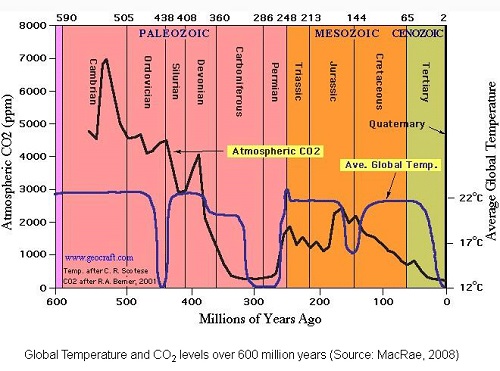Carbon dioxide is under attack by bankers and bureaucrats who are clearly scientifically unqualified to understand the many benefits of this gas of life. Today’s atmospheric carbon dioxide level at around 410 parts per million (ppm) is well below optimum, and even a doubling or tripling of concentration should be welcomed to help green the planet with enhanced photosynthesis. This will increase crop yields, feed the world and benefit flora and fauna alike.

Christiana Figueres, who was executive secretary of the United Nations Framework Convention on Climate Change through the Paris Agreement, complained that world is waiting for a “suicidal” Australia to reverse its stance on climate change. “I’ve been pretty vocal about my frustration for so many years of a completely unstable, volatile, unpredictable stand and position on climate change in Australia”, Figueres told John Connor, chief executive of the Carbon Market Institute in a conversation recorded for the 2-4 December Australasian Emissions Reduction Summit 2020. ANZ and BP were the big-business multinational “Diamond Sponsors” of the event.
The Financial Stability Board’s 23 November 2020 report, The Implications of Climate Change for Financial Stability, claims a disorderly transition to a low carbon economy could have a destabilising effect on the financial system. The report prescribes “an unprecedented reduction in global emissions” to limit global warming to well below 2 °C above pre-industrial levels. Why would the bankers at the FSB want to restrict a life-giving gas? Would it be the same reason why they devised the global bail-in regime to fleece depositors’ money in a banking crisis?
The frustration expressed by Figueres and the bankers at the FSB shows that not everyone buys their climate alarmism and several governments are reluctant to destroy their economies in the name of net-zero carbon. And this frustration is further evidence that the bankers’ “great reset” plan of the Davos World Economic Forum is not inevitable. The Citizens Party has a years-long track record of exposing climate pseudoscience through distributing millions of papers and emails. This has in large part shifted the political debate on climate change, much to the fury of the banking establishment behind climate alarmism.
An 8 June 2020 scientific paper, Dependence of Earth’s Thermal Radiation on Five Most Abundant Greenhouse Gases, by Professors William Happer and William van Wijngaarden, concludes that “at current concentrations, the forcings from all greenhouse gases are saturated”. In other words, insignificant global warming will result no matter how much carbon dioxide levels rise! Happer is Professor Emeritus at Princeton University’s Department of Physics in the USA; Van Wijngaarden is a Full Professor at York University’s Department of Physics and Astronomy, Canada. This paper covers the physics of the matter, but geologists have long known that proxy evidence shows carbon dioxide concentrations have never been a significant driver of temperature change. For example, the Andean-Saharan glaciation occurred during the Paleozoic Era from 450 to 420 million years ago. But during this Ice Age, carbon dioxide concentration was around 4,000 ppm, ten times today’s concentration!
The Global Warming Petition Project debunking the theory of manmade global warming, signed by 31,487 American scientists (9,029 with PhDs), noted that “there is substantial scientific evidence that increases in atmospheric carbon dioxide produce many beneficial effects upon the natural plant and animal environments of the Earth”. The late Australian scientist Professor Bob Carter spelt this out in the Sydney Morning Herald on 27 June 2011: “Extra carbon dioxide helps to shrink the Sahara Desert, green the planet and feed the world. Ergo, carbon dioxide is neither a pollutant nor dangerous, but an environmental benefit.”
Numerous scientific studies reviewed by the Centre for the Study of Carbon Dioxide and Global Change identify the benefits of increased levels of atmospheric carbon dioxide, and since current concentration is only at around 410 ppm—in other words a mere 0.041 per cent of the atmosphere by volume—our natural environment is craving for more. For most of the last 600 million years of life on Earth, atmospheric carbon dioxide concentration exceeded 1,000 ppm and much of the time, including during the era of the dinosaurs, concentration exceeded 2,000 ppm.
Greenpeace co-founder Dr Patrick Moore now advocates the benefits of higher atmospheric carbon dioxide levels in defiance of Greenpeace’s current war on carbon. His March 2015 report, The Positive Impact of Human CO2 Emissions on the Survival of Life on Earth, is an informative read which should shock environmental fanatics back to reality. “This extremely positive aspect of human CO2 emissions must be weighed against the unproven hypothesis that human CO2 emissions will cause a catastrophic warming of the climate in coming years”, writes Dr Moore.
Aside from enhanced photosynthesis which can increase plant growth by 40 per cent or more, scientific studies also indicate that the oceans and sea life will prosper from any additional carbon dioxide. Enhanced nitrogen fixation has been experimentally observed in waters exposed to high levels of carbon dioxide. Studies have also identified that elevated carbon dioxide levels boost iron’s positive impact on phytoplankton productivity. The oceans contain 39,000 gigatonnes of carbon (Gt C), mostly in the form of bicarbonate ions, whereas the atmosphere currently only contains 870 Gt C. And as for coral reefs, they will thrive just as they have done for hundreds of millions of years. Coral expert Dr Peter Ridd, a former professor at James Cook University, has exposed alarmist climate claims that the Great Barrier Reef is in danger. “Corals grow up to twice as fast in the hotter water of Papua New Guinea and the northern Barrier Reef than in the southern reef”, Dr Ridd explained in an article, “Coral can take the heat, unlike experts crying wolf”, published in The Australian in December 2018.
Anthropogenic carbon dioxide emissions merely unlock carbon and return it to the atmosphere whence it came in the first place.
By Jeremy Beck, Australian Alert Service, 9 December 2020






